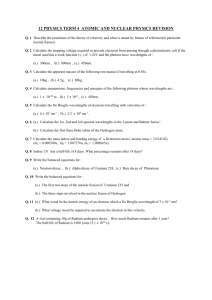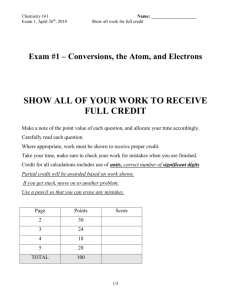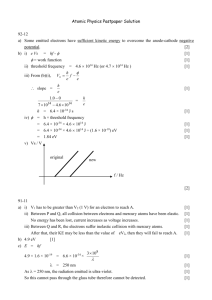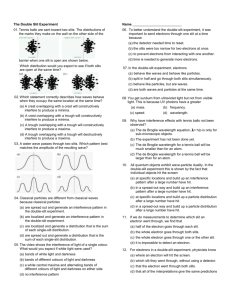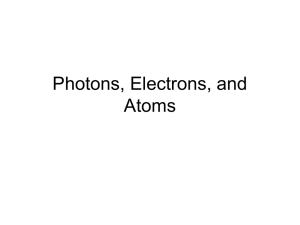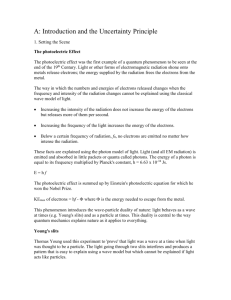Concept Questions
advertisement
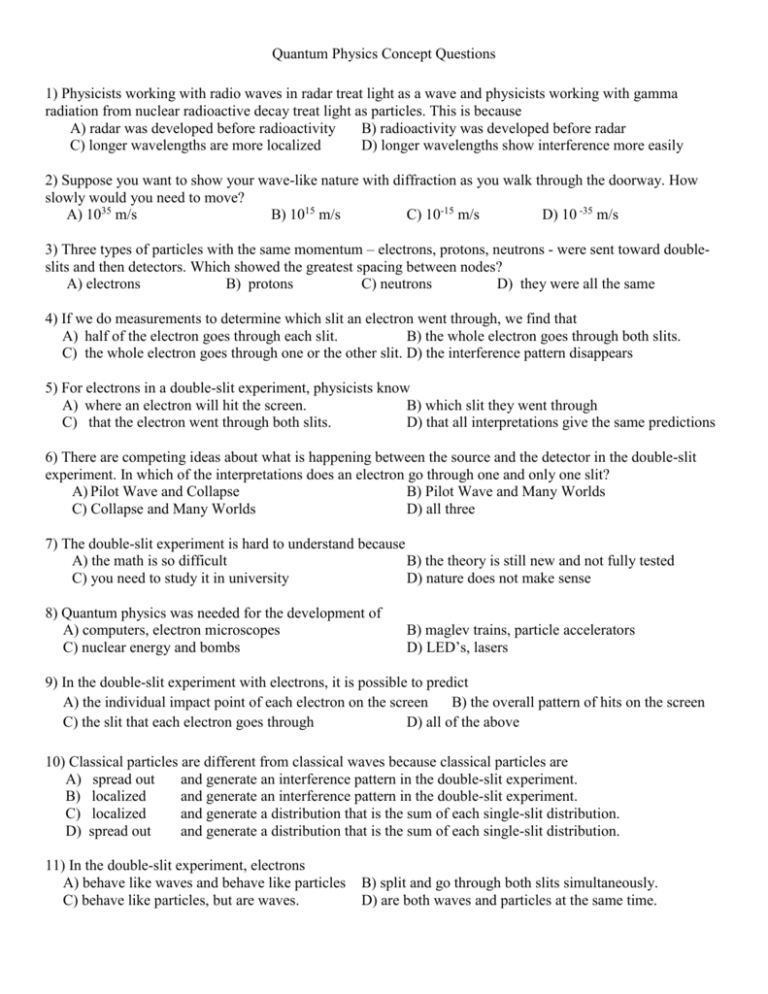
Quantum Physics Concept Questions 1) Physicists working with radio waves in radar treat light as a wave and physicists working with gamma radiation from nuclear radioactive decay treat light as particles. This is because A) radar was developed before radioactivity B) radioactivity was developed before radar C) longer wavelengths are more localized D) longer wavelengths show interference more easily 2) Suppose you want to show your wave-like nature with diffraction as you walk through the doorway. How slowly would you need to move? A) 1035 m/s B) 1015 m/s C) 10-15 m/s D) 10 -35 m/s 3) Three types of particles with the same momentum – electrons, protons, neutrons - were sent toward doubleslits and then detectors. Which showed the greatest spacing between nodes? A) electrons B) protons C) neutrons D) they were all the same 4) If we do measurements to determine which slit an electron went through, we find that A) half of the electron goes through each slit. B) the whole electron goes through both slits. C) the whole electron goes through one or the other slit. D) the interference pattern disappears 5) For electrons in a double-slit experiment, physicists know A) where an electron will hit the screen. B) which slit they went through C) that the electron went through both slits. D) that all interpretations give the same predictions 6) There are competing ideas about what is happening between the source and the detector in the double-slit experiment. In which of the interpretations does an electron go through one and only one slit? A) Pilot Wave and Collapse B) Pilot Wave and Many Worlds C) Collapse and Many Worlds D) all three 7) The double-slit experiment is hard to understand because A) the math is so difficult B) the theory is still new and not fully tested C) you need to study it in university D) nature does not make sense 8) Quantum physics was needed for the development of A) computers, electron microscopes C) nuclear energy and bombs B) maglev trains, particle accelerators D) LED’s, lasers 9) In the double-slit experiment with electrons, it is possible to predict A) the individual impact point of each electron on the screen B) the overall pattern of hits on the screen C) the slit that each electron goes through D) all of the above 10) Classical particles are different from classical waves because classical particles are A) spread out and generate an interference pattern in the double-slit experiment. B) localized and generate an interference pattern in the double-slit experiment. C) localized and generate a distribution that is the sum of each single-slit distribution. D) spread out and generate a distribution that is the sum of each single-slit distribution. 11) In the double-slit experiment, electrons A) behave like waves and behave like particles C) behave like particles, but are waves. B) split and go through both slits simultaneously. D) are both waves and particles at the same time. 12) An object can never be completely at rest because that would violate A) wave-particle duality B) the Compton Effect C) the de Broglie wave equation D) Heisenberg’s Uncertainty Principle 13) Diffraction through a slit illustrates Heisenberg’s Uncertainty principle. If the slit is made smaller A) x is smaller so this means p must be smaller B) x is smaller so this means p must be bigger C) x is bigger so this means p must be smaller D) x is bigger so this means p must be bigger 14) In the photoelectric effect, increasing the frequency of incident light on a metal surface A) decreases the number of electrons emitted B) decreases the kinetic energy of the electrons C) increases the number of electrons emitted D) increases the kinetic energy of the electrons 15) In the photoelectric effect, increasing the intensity of incident light on a metal surface A) decreases the number of electrons emitted B) decreases the kinetic energy of the electrons C) increases the number of electrons emitted D) increases the kinetic energy of the electrons 16) The spectra of incandescent lights, LED’s and lasers are different. When ordered from largest range of colours to the smallest, you would have A) incandescent lights, lasers then LED’s B) incandescent lights, LED’s then lasers C) lasers, incandescent lights, then LED’s D) lasers, LED’s then incandescent lights 17) If the electron behaved like a classical particle orbiting the nucleus it would A) emit a discrete spectrum B) emit a discrete and spiral into the nucleus C) emit a continuous spectrum D) emit a continuous and spiral into the nucleus 18) An atom has energy levels of 0 eV, 5.0 eV and 15.7 eV. It is hit by an electron with an energy of 13.0 eV which excites a bound electron. What are all the photon energies that could be emitted when the electron de-excites? A) 5.0 eV B) 5.0 eV, 13.0 eV C) 5.0 eV, 15.7 eV D) 5.0 eV, 10.7 eV, 15.7 eV 19) An atom has energy levels of 0 eV, 5.0 eV and 15.7 eV. It is hit by a photon. What are all the photon energies that an electron in the ground state could absorb? A) 5.0 eV B) 5.0 eV, 15.7 eV C) 5.0 eV, 10.7 eV D) 5.0 eV, 10.7 eV, 15.7 eV 20) Fluorescent colours are a result of atoms absorbing energy from A) electrons and emitting photons with less energy B) electrons and emitting photons with the same energy C) photons and emitting photons with less energy D) photons and emitting photons with the same energy 21) To get a laser working you need a tube with mirrors at each end and atoms with a A) population inversion and stimulated emission B) population inversion and spontaneous emission C) short lifetime and stimulated emission D) short lifetime and spontaneous emission For the next four questions assume that the polarizing filters are perfect. 22) A photon of unpolarized light heads toward a polarizing filter. What passes through? A) a photon B) half a photon C) nothing D) either a photon or no photon 23) A photon passed through a vertical filter and heads toward another vertical one. What passes? A) a photon B) half a photon C) nothing D) either a photon or no photon 24) A photon passed through a vertical filter and then heads toward one at 45o. What is the probability that the photon passes through the second filter? A) 0% B) 12.5% C) 25% D) 50%

